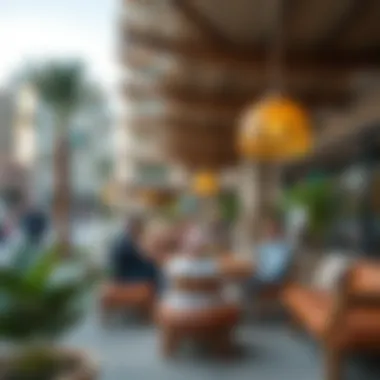Yas Island: A Model for Sustainable Urban Living


Intro
Yas Island stands at the forefront of a remarkable shift in urban development, presenting a model that marries modernity with sustainability. As cities around the world grapple with rapid urbanization, the pressing need for ecological awareness only intensifies. This narrative around Yas Island highlights how it not merely keeps pace with this challenge but effectively sets a new standard for urban living.
Within this vibrant community, dynamism abounds—bringing together eco-friendly architecture, cutting-edge technologies, and vibrant community life all in one space. As we delve deeper, we will explore how its architectural design and thorough planning contribute toward bigger visions not just for the UAE but for urban environments globally. The potential lessons gleaned from Yas Island might just steer future city planning in similar directions, encouraging cities to balance both environmental responsibilities and the needs of their residents.
What Yas Island achieves isn’t just a complacent existence; it beckons those—be it investors, future homeowners, or urban planners—to seek new perspectives on sustainable living.
Market Insights
Current Trends in Dubai Real Estate
In recent years, the Dubai real estate market has witnessed an impressive transformation, evidencing a steady growth trajectory. What began as a speculative bubble has now developed into a refined landscape characterized by a blend of luxury and sustainability. Investors eager to capitalize on emerging opportunities find Yas Island’s unique offerings particularly enticing. The island embodies both leisure and lifestyle—engenders equilibrium with nature while appealing to the affluent market segment.
Moreover, there's a palpable shift toward community-driven developments, integrated with smart technology solutions. Properties on Yas Island increasingly incorporate sustainable practices—such as solar energy systems, water conservation technologies, and green building certifications—making them not just appealing options but also importantly compliant with global eco-standards.
Price Fluctuations and Forecasts
The prices of real estate properties in Dubai have shown fluctuations, tied closely to market demand and economic factors. Yas Island, however, has positioned itself as resilient against the storms of such volatility. Analyses indicate a steady appreciation of property values due to its prime location and burgeoning popularity among expatriates and local residents alike. Given the ongoing urban development and innovations invested in smart infrastructure, forecasts suggest continued upward trends in property values.
"Investors looking towards Yas Island should consider how its commitment to sustainability adds intrinsic value to their investments."
Overall, those keeping a keen eye on market trends will find Yas Island well-poised for growth, offering potential not only for immediate returns but also lasting value.
Property Buying Guides
Steps to Buy Property in Dubai
Buying property in Dubai, particularly on Yas Island, can be an exciting prospect. Here are key steps to consider:
- Research the Market: Understanding the landscape is crucial. It allows potential buyers to identify areas, like Yas Island, that align with their aspirations.
- Engage an Experienced Realtor: A knowledgeable real estate agent can offer insights specific to the area, maximizing the chances of a satisfactory purchase.
- Secure Financing: Know your budget. Some buyers may opt for mortgages through local banks, while others might pay in cash.
- Legal Agreements and Due Diligence: Before you finalize a deal, ensure all documentation is in order. Verify property titles and local regulations.
- Complete the Transaction: Once all checks are cross-checked, finalize the sale—typically requiring payment and registration.
Legal Considerations for Buyers
When buying property in Dubai, it’s advised to keep in mind local laws that might differ significantly from those in other countries:
- Understand residency options—certain property investments can provide residency visas.
- Familiarize yourself with the fees associated with property purchases, such as registration charges and service fees.
- Be aware of the potential return on investment laws, ensuring that any future rental or sale aligns with regulations.
Through understanding these processes, potential buyers can navigate the complexities of real estate transactions with greater confidence, ensuring they make informed decisions in this dynamic market.
In summary, Yas Island's proactive approach towards sustainable development lays a foundation for a future that other cities may well aspire to emulate, bringing together nature, technology, and community into the urban fabric.
Prolusion to Sustainable Urbanism
Sustainable urbanism isn’t just a trendy buzzword; it's becoming the backbone of future city planning. As cities expand and populations surge, the necessity for sustainable living practices has never been more pressing. This section of the article will elucidate the core principles of sustainable urbanism, laying the groundwork for understanding Yas Island's approach to redefining urban life in a way that's environmentally, economically, and socially responsible.
Defining Sustainability in Urban Contexts
When we speak of sustainability in urban contexts, we aren't merely referring to the green facades or the latest technology in solar panels. It's a multifaceted concept that integrates environmental health, economic viability, and social equity. To put it simply:
- Environmental Health involves minimizing urban sprawl, conserving ecosystems, and reducing carbon footprints through effective resource management.
- Economic Viability ensures that as cities invest in sustainable practices, they also foster growth and job creation, paving the way for innovation and market resilience.
- Social Equity emphasizes the importance of inclusivity in urban design, so that everyone has a stake in the future of their city, engaging community members in planning and development.
This holistic approach is not merely an ideal; it's a necessity for cities like Yas Island, where striking a balance among these aspects can lead to a thriving, sustainable environment.
Importance of Sustainable Cities
The significance of sustainable cities lies in their ability to enhance the quality of life for residents while simultaneously addressing climate challenges. Here are some key points to consider:
- Air Quality Improvement: Sustainable cities prioritize green spaces and low-emission transportation alternatives, leading to cleaner air and healthier populations.
- Resource Efficiency: Through smart planning and technology, sustainable urban areas optimize the use of resources like energy and water, crucial for urban resilience, particularly in water-scarce regions.
- Community Engagement: By fostering an environment where local voices influence urban policy and development, sustainable cities not only promote better living conditions but also strengthen community bonds.
- Long-Term Economic Benefits: Investments in sustainable infrastructure can lead to reduced long-term costs associated with healthcare, environmental restoration, and disaster management.
In essence, sustainable urbanism represents a paradigm shift in how we conceive of communities and cities. It underscores the urgency of developing urban spaces that are not just habitable today but are resilient and vibrant for future generations.
"Sustainable urbanism stands at the intersection of environmental stewardship, economic opportunity, and social inclusion."
As we delve into the specifics of Yas Island later in this article, it's essential to recognize that this approach to urban living will support broader sustainability goals across the UAE. Sustainable cities pave the way for innovation and provide vital lessons for other metropolitan areas around the globe.
Yas Island: A Paradigm of Sustainability
Yas Island stands as a shining example of sustainable urbanism, tightly woven into the broader fabric of modern urban living. It's not just a plot of land filled with luxury resorts and amusement parks; instead, Yas Island is a meticulously planned environment that champions sustainability in myriad ways. The island's commitment to creating a harmonious balance between ecological preservation, urban development, and community engagement sets it apart as a model for other aspiring eco-cities.
Geographic and Demographic Overview
Yas Island, located just off the coast of Abu Dhabi, encompasses 25 square kilometers teeming with possibilities. Nestled in the sparkling waters of the Arabian Gulf, the island is easily accessible, making it a prime location for both residents and visitors alike. It was creatively developed to cater to a wide demographic spectrum, from wealth-seeking expatriates to families looking for recreational havens.
The population dynamics are fascinating, as Yas houses a blend of residents who come from various cultural backgrounds. This diversity enriches its community and spearheads conversations that drive innovative ideas to improve urban living. For anyone eyeing investments or residency, the demographic growth on Yas Island signals a vibrant living environment that promises not just housing but a lively community life.


Vision and Development Goals
The vision for Yas Island is ambitious yet grounded in realism—a blend of optimal urban planning and sustainability. Key objectives include:
- Environmental Responsibility: The aim is to minimize the ecological footprint of development projects. From water conservation to implementing eco-friendly facilities, every initiative is tailored to respect and nurture the surrounding environment.
- Integration of Technology: Smart technology is at the core of Yas Island’s infrastructure—a necessary ingredient in 21st-century urban living. The embracing of IoT (Internet of Things) ensures everything from traffic management to energy efficiency is optimized for better living standards.
- Community Among the Trees: Green spaces are plentiful, with parks and recreational areas designed to promote outdoor activities and social interaction. These areas serve as communal hubs where families can gather, children can play, and residents can engage in recreational pastimes.
In summary, Yas Island is carving a niche as a model for urban sustainability through its attention to geographic advantages and an inclusive vision for the future—an essential blueprint that other cities can emulate. Its development goals reflect a thorough understanding of what it takes to not merely build a city, but to create a community that thrives sustainably.
Architectural Innovations
Yas Island stands as a compelling model for how architectural innovations can redefine sustainable urban living. The integration of advanced design techniques and sustainable practices is at the heart of the island's unique architectural identity. This concept doesn't merely exist in the realm of aesthetics; it's also about function, durability, and the environment. Here are some crucial elements that characterize the architectural innovations on Yas Island:
- Sustainable Development Principles: The architectural landscape adheres to stringent sustainability guidelines, ensuring that buildings not only look good but also work effectively within their environments.
- Energy Efficiency: Structures are designed to minimize energy consumption with features like natural ventilation and optimal orientation to maximize daylight.
- Environmental Harmony: Architectural styles on the island reflect the local ecosystem and landscape, making for a seamless transition between built and natural environments.
The inherent benefits of these innovations extend far beyond the buildings themselves. They promote a lifestyle that respects the environment, fosters a sense of community, and bolsters local economies through the utilization of regional resources. By focusing on sustainable architecture, Yas Island also strives to influence other urban developments in the UAE and globally, creating a ripple effect that encourages eco-friendly practices.
Eco-Friendly Building Materials
A significant hallmark of Yas Island’s architectural innovation is the emphasis on eco-friendly building materials. This choice is critical, as the materials used dictate not only the ecological footprint of a structure but also its overall lifespan and efficiency. Building with sustainable materials contributes to:
- Reduced Resource Depletion: By utilizing recycled and locally sourced materials, projects diminish the demand for new resources, lessening the environmental burden.
- Lower Emission Rates: Eco-friendly materials often have a smaller carbon footprint, contributing to cleaner air and overall local environmental health.
Some specific examples of these materials on Yas Island include:
- Recycled steel for structural supports, which significantly reduces waste and energy consumption compared to traditional steel.
- Bamboo for flooring, known for its rapid renewability and strength. This is a fascinating alternative that reflects a growing interest in indigenous building techniques.
- Low-VOC finishes and paints that improve indoor air quality, a crucial factor in maintaining healthy, livable spaces.
Shifting towards such building materials is not only a responsible approach but a necessary one for future-proofing urban spaces against climate change and resource scarcity. For potential investors and homebuyers, this can translate to long-term value and sustainability.
Designing for Resilience
Designing for resilience is an essential forward-thinking approach in the architectural narrative of Yas Island. Resilience in architecture pertains to the ability of a structure to withstand environmental challenges, adapt to changing conditions, and remain functional in crisis situations. This principle is vital when considering:
- Adaptability to Climate Change: Built structures must be able to cope with extreme weather events typical of the UAE region, such as dust storms and extreme heat. Innovations in materials and designs help properties endure these conditions without losing integrity.
- Long-lasting Infrastructure: Using robust materials and design strategies that focus on longevity reduces maintenance costs and resource needs over time.
Some key features that exemplify resilient design on Yas Island include:
- Flood-resistant foundations, anticipating possible climate-related challenges in coastal areas.
- Green roofs that not only provide insulation but also manage stormwater effectively, reducing runoff and enhancing biodiversity.
In a world increasingly threatened by climate instability, Yas Island serves as a compelling blueprint for other urban landscapes, showcasing that resilience is not only achievable but essential for the endurance of modern cities.
"Architecture should speak of its time and place, but yearn for timelessness." - Frank Gehry.
Through initiatives built on solid architectural innovations, Yas Island sets a robust example for future urban environments.
Sustainable Mobility Solutions
In the context of Yas Island, sustainable mobility solutions are not just an accessory to urban life; they serve as a cornerstone for shaping how residents and visitors engage with the environment. With an emphasis on decreased reliance on fossil fuels, enhanced air quality, and greater accessibility, these solutions embody the essence of sustainable urbanism. The success of Yas Island's sustainable practices hinges heavily on innovative approaches to mobility, reducing environmental impact while fostering a vibrant community.
Public Transportation Systems
Sustainable public transportation systems are the lifeblood of Yas Island. The island’s commitment to reducing traffic congestion and pollution is evident in the development of an integrated public transit network. This network not only connects key areas but does so in a way that is environmentally sensitive.
- Electric Buses: One noteworthy component is the fleet of electric buses that glide unassumingly through the island, minimizing the carbon footprint. Utilizing renewable energy sources for charging further amplifies their eco-friendly impact.
- Bicycle Sharing Programs: Complementing the bus system, bicycle-sharing programs have been implemented, promoting physical activity and reducing reliance on motor vehicles. The ease of accessing a bike at designated stations encourages residents to choose two wheels over four.
- Smart Ticketing Systems: A smart ticketing system enhances user experience, allowing seamless transfers between different modes of transport. This integration has been crucial in cultivating a culture of public transport reliance among residents.
"Public transport is a vital step, not just a mode of getting around. It transforms urban identity."
— Urban Development Expert
Pedestrian-Friendly Infrastructure
Creating a welcoming environment for pedestrians is another significant attribute of Yas Island's approach to sustainable mobility. The island is designed for people, not just for cars, emphasizing the importance of pedestrian-friendly infrastructure.
- Wider Sidewalks and Green Walkways: Wider sidewalks have been established, leading to green walkways adorned with trees and plants, fostering a sense of community. These paths not only provide safe spaces for walking but also contribute to the island’s aesthetic.
- Traffic Calming Measures: Implementing traffic calming measures, such as raised crosswalks and speed bumps, enhances safety for pedestrians, encouraging them to stroll freely around shopping centers and leisure areas.
- Mixed-Use Developments: The design of mixed-use developments means that residential areas, shopping, and entertainment facilities are all within walking distance. This urban layout reduces the need for cars and promotes a healthier lifestyle.
By prioritizing these sustainable mobility solutions, Yas Island stands as a testament to what thoughtful urban planning can achieve. The intersection of public transit, pedestrian infrastructure, and community engagement not only propels environmental efforts but also enriches the quality of life for everyone on the island. As this model unfolds, it lays the groundwork for other regions striving to integrate sustainability in their urban landscapes.
Energy Efficiency and Renewables
As the world grapples with the pressing need for sustainability, the focus on energy efficiency and renewable resources has never been more critical, especially in urban centers like Yas Island. With its commitment to sustainable development, Yas Island exemplifies how energy considerations can significantly shape urban living. Investing in energy efficiency isn't just a benefit for the environment; it brings tangible advantages to residents and businesses alike, such as lower energy costs and increased property value, thus attracting more investors and homebuyers.
Energy efficiency measures on Yas Island aim to reduce overall energy consumption while maintaining comfort and convenience for its residents. By focusing on renewable resources, the island is setting a standard that could inspire future urban developments across the globe.
Incorporation of Solar Energy
Solar energy is one of the most promising forms of renewable energy, and its incorporation into Yas Island's infrastructure represents a major stride towards a sustainable future. The island has embraced solar technology, installing solar panels on rooftops, parking lots, and public spaces to harness the sun's abundant energy. With the blistering sun shining over the UAE, solar power can cover a significant portion of the energy demands.
Here are key elements of solar energy integration on Yas Island:
- Diverse Installations: Solar panels are strategically placed on residential units and commercial buildings, which helps to maximize efficiency by generating energy at the point of use.
- Government Incentives: The UAE government supports solar energy initiatives through various subsidies and incentives, making it practical for residents and developers to invest in solar solutions.
- Contribution to Grid: Excess energy produced from private and public installations can feed back into the grid, offering the chance for community-wide benefits and efficiencies.


Utilizing solar energy not only reduces the carbon footprint but also strengthens the energy resilience of Yas Island, creating a self-sufficient urban community.
Energy-Management Systems
An effective energy-management system is crucial for optimizing energy usage on Yas Island. These systems utilize smart technology to monitor, control, and reduce energy consumption across different sectors. With the help of data analytics, residents can track their energy use in real-time, making informed decisions about consumption patterns.
The benefits of implementing advanced energy-management systems are manifold:
- Informed Decision-Making: Residents can access information about their energy use, which allows them to adapt their behavior and reduce wastage.
- Predictive Maintenance: The system can alert authorities or companies about infrastructure issues before they escalate, ensuring smooth operations and energy distribution.
- Integration with Smart Appliances: Energy-management systems enable compatibility with smart-home technology, allowing for seamless interaction between devices to optimize energy usage.
In summary, Yas Island’s commitment to effective energy-management systems enhances its position as a forerunner in sustainable urban development. By merging energy efficiency with renewable resources, the island sets a benchmark for others looking to embrace sustainable living, ensuring a brighter, greener future for its inhabitants.
"Energy efficiency is not just about saving money; it's about improving the quality of life and creating a sustainable world for future generations."
For further reading on sustainable energy solutions, check out Energy.gov and Wikipedia.
Water Conservation Strategies
Water conservation has become a cornerstone in the discussion surrounding sustainable urban development. As cities grow, the demand for water increases significantly, and failure to implement effective strategies can lead to resource depletion and environmental degradation. Yas Island embodies a forward-thinking approach to this pressing issue, featuring a variety of systems designed to minimize water waste and enhance sustainability. By prioritizing water conservation, Yas Island ensures not only the well-being of its residents but also the preservation of the natural ecosystem, affirming its role as a model for future urban developments.
Smart Irrigation Technologies
In an age where technology intertwines with everyday life, smart irrigation stands at the forefront of water conservation efforts. On Yas Island, these technologies utilize real-time data to optimize watering schedules and amounts for parks and gardens.
The integration of sensors and weather forecasting tools allows for irrigation only when necessary, reducing waste while maintaining the island's lush landscapes.
Some key features include:
- Soil moisture sensors: These devices assess the moisture levels in the soil to deliver precise watering, ensuring that plants receive only what they need.
- Weather-based controllers: Utilizing local weather data, these systems can adjust watering schedules based on rainfall forecasts and temperature fluctuations.
Implementing such technologies can yield substantial benefits, such as improved plant health, reduced labor costs, and significant water savings. These innovations illustrate how a data-driven approach to irrigation fosters a sustainable environment, allowing residents to appreciate green spaces without burdening natural resources.
Recycling and Wastewater Management
Proper management of wastewater also plays a pivotal role in achieving water conservation goals on Yas Island. The island embraces treatment systems that convert wastewater into reusable water, contributing to a more circular economy. This approach reduces fresh water consumption and enhances resilience to drought conditions.
Key strategies include:
- On-site sewage treatment plants: These facilities treat wastewater directly at the source, allowing for immediate reuse in irrigation or non-potable applications.
- Greywater recycling systems: These systems capture and purify water from sinks, showers, and laundry, repurposing it for landscape irrigation or toilet flushing.
The advancement in recycling technologies not only bolsters the island’s water conservation efforts but also encourages community participation in sustainability practices. By emphasizing the importance of responsible water use, Yas Island fosters a culture of environmental stewardship that residents can embrace.
"Water conservation is not merely an option; it is a necessity for future urban living. Yas Island demonstrates that innovation and sustainability can work hand in hand."
The combination of smart irrigation and comprehensive wastewater management creates a robust framework for water conservation, ensuring that Yas Island remains a paragon of sustainable urban living. As investors and stakeholders look toward the future, these strategies serve as exemplars, offering insights into how responsible resource management can yield a thriving, sustainable urban environment.
Community Engagement and Social Sustainability
Community engagement and social sustainability are essential for crafting a thriving urban environment, especially on Yas Island, where the focus is not just on building structures but fostering a cohesive community. When residents and stakeholders actively participate in shaping their surroundings, they create a sense of belonging and ownership. This collaborative effort often leads to innovative problem-solving and improved living conditions, directly impacting the quality of life and the overall sustainability of the area.
Key components of social sustainability include the promotion of social equity, access to necessary resources, and the cultivation of a vibrant public life. Yas Island exemplifies this through various initiatives aimed at involving the community in decision-making processes. By organizing workshops, forums, and feedback sessions, the developers ensure that the voices of residents play a crucial role in the urban planning narrative.
Moreover, strong community ties contribute to resilience, enabling neighborhoods to respond effectively to challenges such as climate change and economic shifts. This relationship fosters collaborations, whereby local problems are addressed with innovative local solutions.
"Engaged communities are more adaptable and invested in their environment, leading to sustainable living practices that last over time."
Inclusive Urban Planning Practices
Inclusive urban planning practices focus on creating spaces that accommodate varied lifestyles and needs. In Yas Island, the integration of feedback from diverse community segments has led to more equitable designs that cater to families, young professionals, senior citizens, and tourists alike. This participation resonates with the broader goal of ensuring that urban spaces serve all demographics, rather than just a select few.
To achieve this, planners must prioritize accessibility and give special attention to underrepresented groups. For instance, features such as wheelchair-friendly walkways and community gardens not only enhance the livability of the island but also encourage social interaction among residents. This sense of community is pivotal in maintaining social harmony and stability.
Here are some specific elements that highlight inclusive planning:
- Public spaces designed for gatherings and events, fostering community interaction.
- Affordable housing options that ensure residents from different economic backgrounds can live comfortably.
- Educational facilities that cater to a diverse student body, contributing to a well-rounded society.
Promoting Local Businesses and Employment
Supporting local businesses is pivotal for creating jobs and stimulating economic growth within Yas Island’s sustainable framework. When residents shop locally, they nourish their community, leading to a ripple effect that boosts the local economy and creates more employment opportunities.
To foster this, initiatives are in place to encourage local entrepreneurship. For example, the development of marketplaces and business hubs allows small startups to flourish, providing them not only with visibility but also the resources they need to succeed. Such efforts ensure that wealth circulates within the community, rather than being siphoned off to external corporations.
Local businesses are also integral to enhancing the community's identity. They offer unique products and services that reflect the island’s culture, making it a distinctive place to live and visit. Some successful strategies include:
- Hosting business development seminars to sharpen skills and knowledge among local entrepreneurs.
- Establishing networking events that connect local businesses with potential customers and investors.
- Collaborating with educational institutions to provide internship and training programs that align students with local industries.
In summary, fostering community engagement and promoting local businesses are crucial building blocks for achieving social sustainability on Yas Island. These practices not only improve the quality of life for residents but also align with broader sustainability goals, setting a compelling example for future urban developments.
Impact of Yas Island on the UAE's Sustainability Goals


Yas Island stands as a cornerstone of the United Arab Emirates' strategy to foster sustainable development. It embodies a vision that aligns with the national sustainability goals by showcasing how urban planning and environmental stewardship can go hand in hand. This significance prompts a closer look at the specific contributions the island makes towards national climate initiatives and regional development.
Contributing to National Climate Initiatives
Yas Island plays a pivotal role in supporting the UAE's national climate initiatives, which aim for a balanced relationship between economic growth and environmental preservation. The island's development is not merely a local aspiration but a reflection of the UAE’s commitment to global standards on climate action. These initiatives are critical as they seek to reduce greenhouse gas emissions, increase energy efficiency, and promote renewable energy sources.
In practical terms, Yas Island has integrated several innovative systems that reduce its carbon footprint. For instance, solar panels installed across various facilities harness the sun's energy, significantly cutting down traditional power consumption. This kind of large-scale implementation of solar power is a clear illustration of a shift towards renewable energy within the urban landscape.
Moreover, Yas Island’s designs promote high energy efficiency through smart systems that monitor and optimize energy usage across its various sectors. This real-time management not only leads to lower operational costs but also encourages sustainable lifestyles among residents and visitors alike.
Challenges and Solutions in Implementation
Implementing a sustainable urban model like Yas Island comes with its share of hurdles. It’s not just about fancy buildings or buzzworthy technologies. The success of such an initiative relies heavily on addressing a plethora of challenges and simultaneously crafting effective solutions. This section delves into the crucial aspects of financial viability and the delicate balance between development and conservation in the face of modern urbanization demands.
Financial Viability of Sustainable Projects
Financial sustainability is a cornerstone for any ambitious urban development project. In the case of Yas Island, investors and stakeholders need to grasp the financial intricacies that accompany sustainable endeavors. While eco-friendly projects often demand higher upfront investment, the long-term savings and revenue from energy efficiency can present a compelling case.
For instance, integrating renewable energy systems—like solar panels—not only aligns with environmental ideals but also slashes operational costs over time. Additionally, the rise in demand for green living spaces can push property values upward, providing returns that appeal to both investors and homebuyers.
However, the challenge doesn’t stop there. The financial landscape can be precarious, with shifts in market dynamics and policy reforms affecting funding availability. It’s crucial for stakeholders to foster partnerships with local governments, NGOs, and private sectors to create a diverse funding ecosystem that’s less susceptible to economic fluctuations. This collaborative approach can also underpin the viability of sustainable initiatives by sharing resources, knowledge, and innovative strategies.
Balancing Development with Conservation
As Yas Island continues to evolve, finding the sweet spot between development growth and environmental conservation is paramount. The temptation to expand commercial and residential spaces can lead to short-sighted decisions that jeopardize ecological integrity. Maintaining harmony in this regard isn’t just an ideal; it’s a necessity for long-term viability.
A significant consideration involves making informed choices about land use. Strategies such as zoning regulations aimed at preserving green spaces and biodiversity hotspots are essential. Encouraging vertical development rather than horizontal sprawl can conserve land while fulfilling the needs of a growing population.
Another promising avenue is the incorporation of biophilic design, which seeks to integrate naturally occurring elements into the urban landscape. This approach not only enriches the aesthetic appeal but also promotes ecological health, improving air quality and providing habitats for local wildlife.
The key is not to view development and conservation as opposing forces but as partners in creating a city that thrives both economically and ecologically.
Future Prospects for Yas Island
The future of Yas Island stands as a beacon of sustainable urban development within the UAE and beyond. By analyzing current initiatives and planning for future improvements, we can better appreciate how Yas Island continues to innovate in renewable energy, community engagement, and smart technology. As cities around the globe grapple with the challenges of urban sprawl and climate change, Yas Island presents a compelling case study of what is possible when foresight and commitment to sustainability align.
Scalability of Sustainable Practices
Yas Island's journey toward sustainability is not a one-size-fits-all approach. Instead, it showcases the scalability of practices that can be adapted and implemented in various urban settings. From its comprehensive public transport system to its green spaces, each element has been meticulously designed with flexibility in mind, aiming to inspire similar developments in other regions.
- Public Transport Expansion: The ability to scale public transportation systems, such as electric buses that cover vast areas, can significantly impact the reduction of carbon footprints. This is especially relevant in densely populated urban areas where vehicular congestion is prevalent.
- Green Building Practices: The adoption of eco-friendly materials and building designs from Yas Island can be modified to suit different climates, allowing various urban contexts to benefit from sustainable architecture.
- Community Gardens and Green Spaces: These can easily be replicated in any city. They not only enhance the community's aesthetic but also encourage biodiversity and improve air quality.
Adopting these scalable practices can drive progress across various regions while promoting the global agenda for sustainability.
Potential for Innovative Technologies
In the realm of urban development, technology acts as the game changer. Yas Island stands at the cutting edge of integrating innovative technologies into its infrastructure, leading the charge for future urban environments. The focus on smart tech not only enhances the quality of life for residents but also guarantees a sustainable future.
- Smart Energy Systems: Utilizing AI and machine learning in energy management can optimize electricity use, reducing waste and lowering costs. For instance, solar panels linked to a central management system can adjust energy usage based on real-time weather data.
- Water-Saving Technologies: Innovative systems that monitor and manage water consumption can reduce waste and harness rainwater more effectively. This is especially critical as water scarcity becomes a pressing issue globally.
- Digital Platforms for Community Engagement: Modern apps that facilitate direct communication between residents and city planners can foster greater involvement in local decision-making. This ensures community needs are met and promotes a collaborative spirit.
In summary, Yas Island exemplifies how urban areas can harness scalable sustainable practices alongside technological innovations, setting a course for other cities to follow.
Closure
The prospects for Yas Island's future are bright. By focusing on scalable sustainable practices and leveraging the potential of innovative technologies, it is positioned not just as a model for other cities, but also as a vital participant in the global movement toward sustainable living. As investors, homebuyers, and urban planners look toward the future, Yas Island is an indicator of the kind of progressive, eco-focused communities that will become necessary in our rapidly changing world.
For those interested in learning more about sustainable cities, refer to Wikipedia and Britannica.
Epilogue and Final Reflections
In assessing the overall framework of Yas Island as a sustainable city, it becomes evident that this venture reflects a powerful commitment to a greener future in urban settings. The combination of innovative technology, environmental stewardship, and community-oriented design provides a valuable blueprint for metropolitan areas elsewhere.
Evaluating Success and Areas for Improvement
Yas Island’s sustainability initiatives have produced a range of benefits, particularly in creating a more livable urban space that attracts diverse demographics.
- Success Indicators:
- Increased green spaces not only enhance the aesthetic appeal of the island but also improve air quality and promote biodiversity.
- The emphasis on public transport and walkability has led to reduced vehicular emissions, contributing significantly to lower carbon footprints.
- Community engagement efforts have resulted in a thriving local economy, which supports small businesses and job creation.
However, areas for improvement exist. For instance, while the accessibility of transport systems is commendable, it remains necessary to evaluate user experience and satisfaction continuously. Additionally, ongoing education about sustainability practices can further enhance community involvement and adherence to environmental standards. Emphasizing active participation can herald further advancements in Yas Island’s vision.
Yas Island's Legacy in Urban Development
Yas Island stands as a testament to what forward-thinking urban development can achieve. Its integration of sustainable practices within the architectural realm serves as a living lesson for cities around the globe. By prioritizing energy efficiency, responsible resource management, and strong community ties, Yas Island is crafting a legacy that goes beyond its geographic boundaries.
The implications of Yas Island's development reach far and wide, influencing policy decisions and urban planning processes in various regions. The lessons gleaned from this island can contribute to building resilient urban infrastructures worldwide.
In essence, Yas Island’s blueprint may well shape future urban environments—showcasing that sustainability can go hand in hand with innovation and community spirit. As interested investors, homebuyers, and developers analyze this case, it remains clear that the possibilities for sustainable urban living are not only attainable, but they are necessary for securing a healthier planet for future generations.
"A sustainable city is not merely a place; it’s a profound movement towards a better quality of life for all inhabitants."
Through this lens, Yas Island not only meets contemporary needs but also lays the groundwork for smart growth that harmonizes with nature's rhythm.















